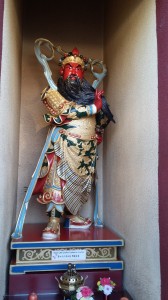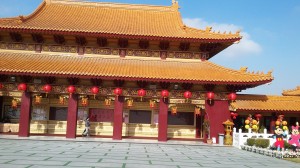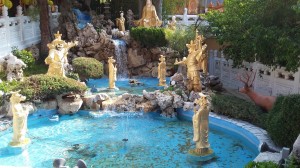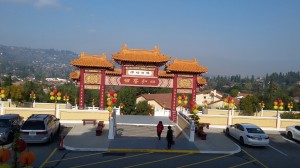THE HSI LAI TEMPLE
THE HSI LAI TEMPLE
By Charles N. Stevens
Photos by Dolores Seidman
We hadn’t gone a mile from the 60 Freeway on Hacienda Boulevard in Hacienda Heights when we first saw the curved roof of the His Lai Temple emerge out of the morning haze. It is an astounding fact that the largest Buddhist Temple in the United States is only a 20-minute drive from Monterey Park.
In the chill morning we climbed the first set of stairs, passing under the welcoming gateway on our way to meet our guide. We were told that the symbols on the gateway list the four universal Buddhist vows. These are to save all sentient beings, eradicate delusion and stress, to study the vast teachings of Buddhism and to attain supreme enlightenment.
Using a handy elevator, we rose to the next floor with our guide to the Bodhisattva Hall. The fragrance of incense filled the air. A Bodhisattva is an enlightened sage. Four of them were represented in the hall by colorful statues. Below them was a long altar table. I watched people place apples and oranges as well as large plant in a glass vase on the altar. When they placed their offering, they backed a step then bowed slightly in respect for the statue above. Other people placed shallow boxes of fruit, flowers and other small objects on the altar that they “rented” from a booth at the side of the hall. These offerings had to be returned. We enjoyed watching the people.
We moved on the Main Shrine where formal religious services are conducted. This was a large room where 10,000 Buddhas were set into the walls, each peering out at the people. In the front of the room were three statues of what they call Sakyamuni Buddhas, those who possess the heroic qualities of wisdom, virtue, compassion and the power to subdue evil. We sat on a bench along the wall at the back of the room, looking up at the imposing statues and rows of low pinkish cushioned seats where people sat for the services. Several people entered the shrine and paid their respect with a slight bow for the enlightened Buddhas.
It was 11:00 a.m. and time for lunch in the dining hall. For a fee of $8 each we joined the short line at the steam tables where vegetarian food awaited us. Buddhists do not believe in eating animals. We passed by the food, examined it and selected what looked good. Some of the vegetables were prepared specially to look like meat. On my plate I selected ramen-like noodles, rice carrots, cauliflower cooked in broth, Chinese broccoli and deep-fried zucchini. I found the food somewhat bland but quite edible.
After lunch, we had quick trips through the museum, the bookstore and especially the gardens. The first one was the Arbat Garden with life-like statues of men who have realized the “truth” of no-self and have overcome the defilement of greed, anger and ignorance.
Another garden complete with a waterfall was adorned with golden statues of men called the Deva Kings who stand among the grass and shrubs. Pools in the front part of the gardens were littered thickly with coins thrown there by the hopeful.
During our visit, we were surrounded by the colorful decorations celebrating The Chinese New Year. Red, orange and yellow lanterns were everywhere while special exhibits lined the edge of the vast courtyard.
We had a wonderful day at the temple and found it interesting and stimulating. It was well worth the short trip. Except for the lunch everything was free.

People were offering gifts to this statue of Bodhisattva.

The main shrine is where services are held.

The garden of the Deva Kingss features these golden statues.

The main entrance to the temple grounds welcomes visitors.
MONTEREY PARK AUTHOR PUBLISHES 4th BOOK – Seeking More of the Sky: Growing Up in the 1930’s:
Charles “Norm” Stevens, a 43 year resident of Monterey Park has recently published his 4th book: Seeking More of the Sky: Growing Up in the 1930’s. This is the story of a young boy growing up in Inglewood, California in the l930’s. This was a time during the depression when unemployment was affecting many and the banks were closed, while the clouds of war were gathering in Europe. But he was lucky enough to be raised in a loving family, the power of that love reflected throughout his stories.
Stevens is the author of three previous books about his experiences during WWII:
An Innocent at Polebrook: A Memoir of an 8th Air Force Bombardier (Story of his 34 bombing missions from his base at Polebrook, England over Germany and France)
The Innocent Cadet: Becoming A World War II Bombardier (A prequel to the first, telling of his training in the U.S. before going overseas into combat.)
Back from Combat: A WWII Bombardier Faces His Military Future from Combat: (This book details the time from when he returned from combat in England until the end of the war.)
He is known to the readers of The Citizen’s Voice as the author of Travel Log Articles including “Cruising the Rhine and Mosel”,” Best of the West”, “In Search of Snow” , “From Paris to Normandy on the Seine”, and “Exploring New York”. He is retired, having taught for 32 years, primarily in the Montebello Unified School District.
Those interested in purchasing an autographed copy of any of his books, may contact the author at 323-721-8230 or Normstevens24@gmail.com.



